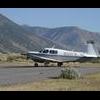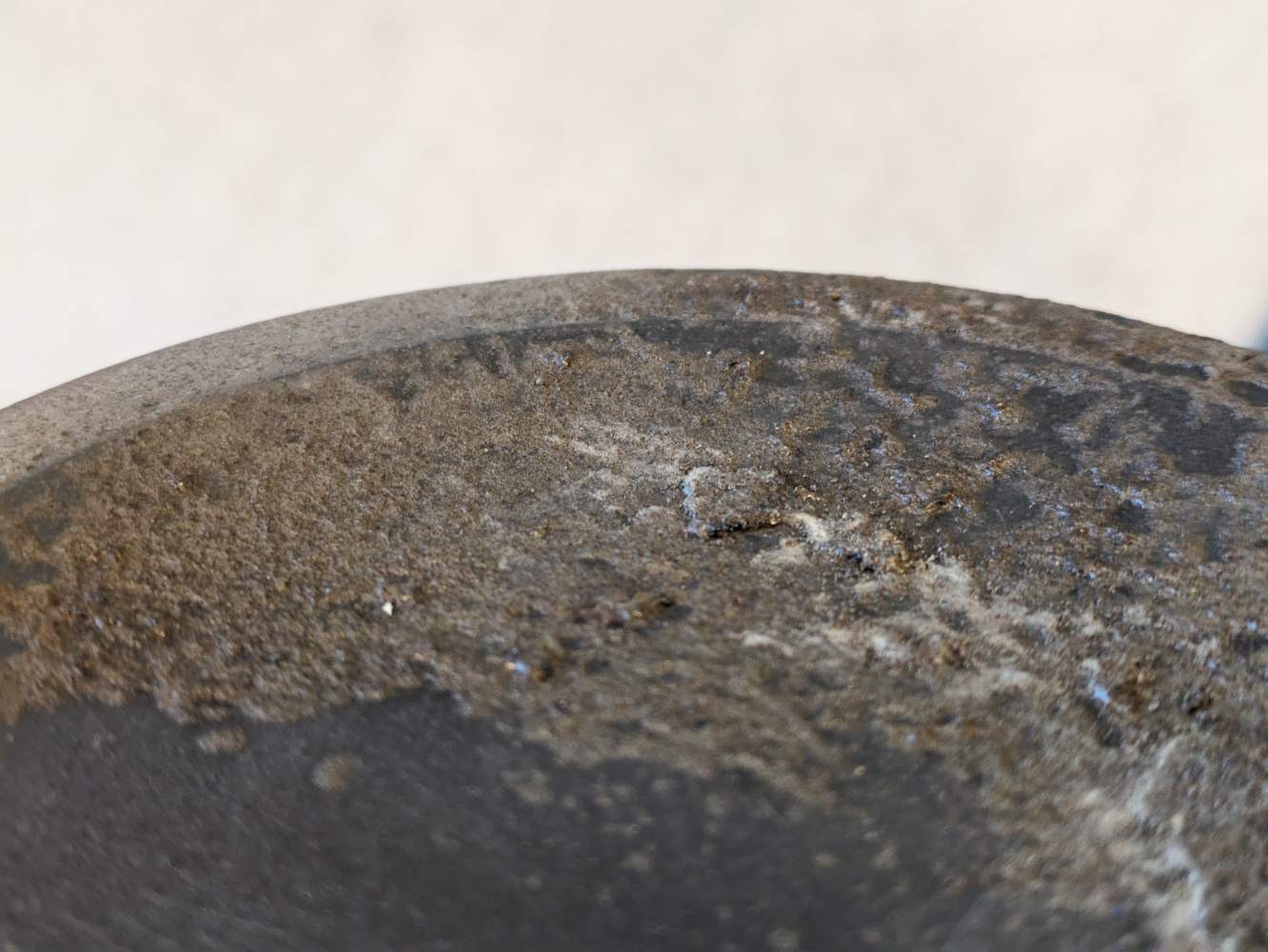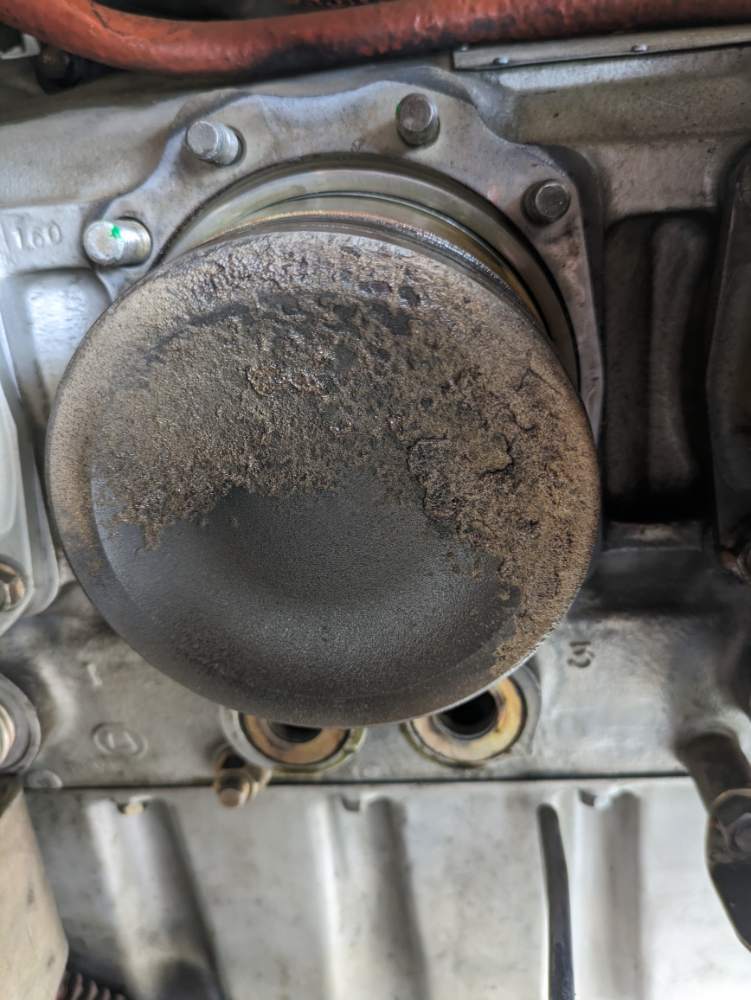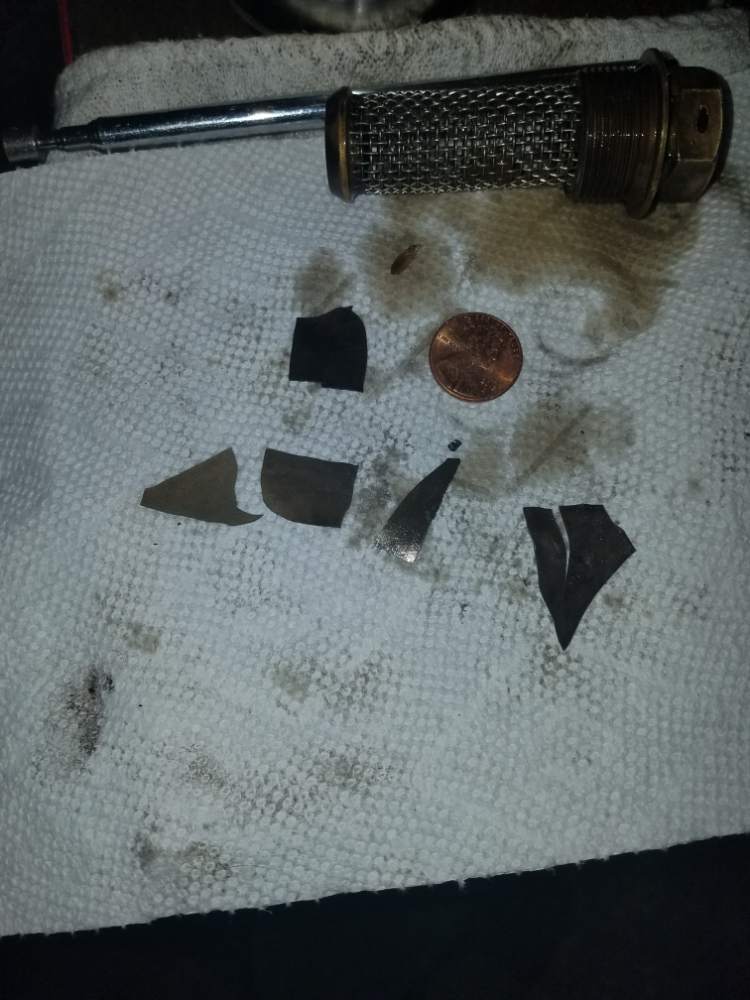-
Posts
47 -
Joined
-
Last visited
Content Type
Profiles
Forums
Blogs
Gallery
Downloads
Media Demo
Events
Store
Everything posted by HeyChuck
-
This engine has now had 5/6 of a "top overhaul" in the past couple years (5 out of 6 cylinders overhauled)...the crankshaft and camshaft are still looking good. I considered doing a major overhaul last year, but there were parts availability problems and delays at that time, not sure if that is still the case. Maybe next year...
-
Thank you for your suggestions and getting input from George Braly. I will take the plane to a shop Wednesday to check the plugs, other cylinders, etc.
-
This is a close-up of the top of the piston in the 10-noon area. The rough spots are built up deposits, not erosion features.
-
Picture of the piston in profile from "10 to noon" aspect. Doesn't feel like melting or erosion around the piston crown to me, but I don't have a lot of experience with this.
-
Attached is a close-up picture of the extracted exhaust valve showing two through-going cracks on the valve head that are tangential to the stem. The picture of the piston shows more deposits on the top; I was told it is fairly common to see more deposits where the fuel comes into the cylinder as it is cooler there. Not sure about detonation because the intake valve and piston don't appear damaged, and the CHT stayed below 400 F.
-
A couple other mechanics I have shown this to had a similar thought. No signs of the classic asymmetric burn pattern that sometimes foretell a failure.
-
Oil consumption was normal before the failure. Maybe the valve started sticking some in the guide and was burnt with blowby?
-
I will do that next time. Thanks.
-
The cylinder compressions were not the concern. The cylinder with 55/80 compression had a leaking exhaust valve but was not burned. More importantly, there was some modest delamination of the Nickel plating on the cylinder wall, which could have progressed and caused further problems. The inspecting IA thought he also saw some anomalous wear on the wall of the cylinder (with 70/80 compression) during borescope inspection, so that cylinder was also replaced. That was likely unnecessary because the minor pit appeared insignificant upon closer inspection.
-
That is an interesting possibility. The mechanic visually inspected the cam and lifter while the cylinder was off, but didn't remove the lifter to test integrity. I don't think any anomalous lack of pressure was noticed when the lifters were bled down during cylinder replacement, but maybe nobody was paying much attention to that.
-
Yes, the plugs, rings, and piston were all fine. The busted valve is still in the removed cylinder, I may take it out for closer inspection.
-
Getting on with it.Because I was far from my home base, it was more expeditious to replace the entire cylinder assembly & piston (even though there was no other damage), then fly home (a week later). Fortunately, the IA who inspected the turbocharger found no damage, so the pieces presumably exited through the exhaust pipe.
-
I was not present when the compression was tested during the annual, but the IA stated "Checked compressions: orifice psi 46, #1-55 #2-80, #3-80, #4-70, #5-79, #6-80." Cylinders #1 and #4 were subsequently replaced. The valves on cylinders #2 and #6 were replaced about 200 hours previously.
-
The exhaust valve in a cylinder of my Continental TSIO-360SB failed during flight (at 1554 hours SMOH). The engine ran rough and cylinder went cold; landed ASAP. The attached picture of the broken valve was taken after we removed the cylinder. This cylinder had compression 80/80 during the annual inspection 24 hours earlier, with no signs of burning during bore-scope inspections. No obvious CHT or EGT anomalies on my JPI EDM-700 were noticed before the failure, but the data were not being recorded. Has anyone seen a valve fail like this?
-
Possibly. It is also possible that a complete teardown will reveal no problem with the lower end. Although 1/10 teaspoon (total volume) of probable cylinder-plate metal was found in the sump, this engine has been very reliable, and currently has excellent cylinder compression, clean oil analysis indicating normal wear, relatively new starter, spark plugs, magnetos, alternator, etc. A Continental engineer thought the flakes likely came from the base of a cylinder during break-in, and advised not to pull any cylinders yet. They may also have worn during a cold, "dry" (minimal lubrication) start. Safety is paramount. Because engine failures are more likely to occur after major maintenance (top or major), careful diagnosis and targeted remediation is the conservative and safer approach than immediate tear down. A long ground-run with subsequent filter and sump inspections should come first. Perhaps removal of one cylinder will enable borescope inspection of the other cylinder's walls that couldn't be seen from above the pistons. Regarding overhauls: Penn Yann and Western Skyways declined to quote because they cannot overhaul within the next year (think supply-chain issues) and/or parts availability and prices are too uncertain. Continental likely has best access to parts for overhaul; Continental quoted $87,258 and 7 months for a factory reman. The least expensive "field overhaul" I have been quoted is over $50K (about $60k with removal/installation, hoses, etc.) with a 6 month turn-around. Others are more expensive with turn around times on the order of 7-8 months, IF they can obtain parts.
-
The lab analysis of this metal (quoted below) is consistent with possible delamination of one of the ECI Cerminil cylinders. Delamination problems on Nickel cylinders have apparently occurred, but may be rare. If that happened in this engine, it must have been near the cylinder base (crankcase side) where it couldn't be seen with the borescope. In another thread someone stated that engine shops are reluctant to hone Cerminil cylinders (for new piston rings)....perhaps it compromises the integrity of the nickel plating? "THE 2 LARGE FLAKES THAT WERE SENT WERE DARK GRAY IN COLOR ON ONE SIDE AND A GREENISH-BROWN ON THE OTHER. THESE PIECES COULD NOT BE MATCHED TO AN AMS NUMBER, CONSISTING OF NICKEL ON ONE SIDE AND LEAD ON THE OTHER. THIS MAY POSSIBLY BE SOME SORT OF PLATING OR ANTI-WEAR COATING. THESE THIN FLAKES MEASURE APPROXIMATELY 1 X 0.75 INCHES AND 1 X 0.625 INCHES. THESE FLAKES ARE FERROUS AND ARE VERY RIGID, BREAKING WHEN PRESSURE IS APPLIED INSTEAD OF BENDING. PLEASE CONTACT THE ENGINE MANUFACTURER'S SERVICE REP IF FURTHER ASSISTANCE IS NEEDED."
-
When you found the sheetmetal looking pieces from the rear engine bearing, were they in the oil screen, paper spin-on oil filter, or both? If you were doing spectroscopic oil analysis, did you see any anomalous trends, such as high copper? Thanks!
-
The spin-on oil filter was clean. Removing the sump is difficult on these Continentals because of the engine mount. The borescope through the drain hold revealed most of the pieces in the picture, and I believe the IA removed what he saw. I don't know if the sump has ever been viewed this way before, so the pieces may have been in the sump a long time, and the one that was relatively skinny eventually got sucked through the pick-up tube to the suction oil screen.
-
Oil consumption has been normal. I will send a sample of the metal to AvLab. Thanks!
-
I don't know how cylinder plating peels off, but I think it would show up as wear metals in the oil analysis over time. These cylinders are Nickel carbide with over 1500 hours and no problems with the cylinder walls to date.
-
I contacted AvLab to arrange a metallurgical analysis which might discern if the alloy is used in cylinder plating vs. bearing cladding. However, now that the IA has seen the metal in the sump, he points out that regardless of the metal provenance, the unknown quantity of additional metal that may be present somewhere in the engine could obstruct the engine oil pump. Although bore scope inspection of the sump does not show more metal, it could be "hiding" somewhere...and the airplane is not safe to fly without an engine teardown...I am afraid I will likely be shopping for a major overhaul next week.
-
Thanks for the follow-up question. The nickel carbide cylinders on this engine have been reliable (1530 hours to date); but had to replace two burned exhaust valves a couple years ago. The spin-on filter element was clean...still waiting for the oil analysis.
-
Found a large piece of thin (.013"), brittle, ferrous metal in the oil suction screen of my TSIO-360SB during the annual inspection today. Further investigation found several larger pieces in the oil sump (picture attached, penny for scale). There is a gentle curve on at least one of them. These are likely too thin and wide to have come from an impulse coupling or push rod spring. We are wondering what might be coming apart (it wasn't the oil dipstick) ... any ideas?
-
I installed a BendixKing KSN-770 along with a KT-74 last July (before the FAA rebate program). The KSN-770 replaced the KX-165, KN-64, and KLN-89B in my old panel. I was experienced with the Garmin units, and used the KSN-770 simulator to become familiar with the different "buttonology" before choosing the KSN-770 over the Garmin and Avidyne units. There were a couple known bugs in the KSN-770 software that I only learned about after installation (annoying), but those have supposedly been corrected in a recent software release. I have not had time to return to the dealer to get that update installed (it is covered under warranty), and will write a more detailed review on this post after I get that accomplished.
-
Useful load in my 1997 Encore (M20K) = 992.7 lbs.











